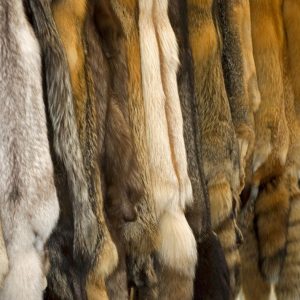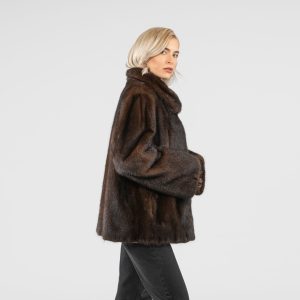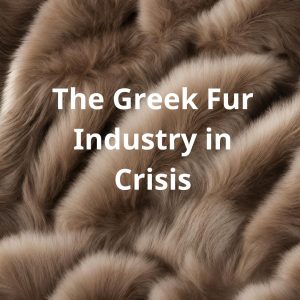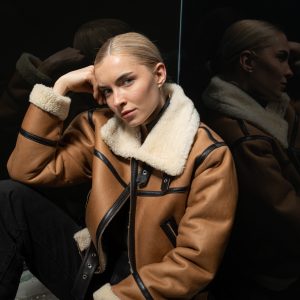28 March
2024
What is causing the rise in fur pelt prices?
In recent times, the fur industry has witnessed a notable trend: a steady ascent in fur pelt prices. This surge, driven by a multitude of factors, has prompted both speculation and analysis within the realms of fashion, economics, and environmental discourse. Understanding the dynamics behind this phenomenon unveils a complex interplay of market forces, regulatory shifts, and environmental considerations.
Demand Dynamics
One of the primary drivers behind the escalating prices of fur pelts is the relentless demand emanating from global fashion markets. Despite occasional ethical controversies and shifts towards alternative materials, fur remains a coveted luxury item in many cultures. The resurgence of fur in high-end fashion collections, coupled with the burgeoning demand from emerging markets, has created sustained pressure on the supply chain, leading to price hikes.
Supply Constraints
On the supply side, various factors have constrained the availability of fur pelts, further exacerbating the price surge. Regulatory measures aimed at animal welfare, such as bans on fur farming or stringent trapping regulations, have significantly impacted fur production in certain regions. Consequently, the supply of high-quality fur pelts has dwindled, forcing buyers to compete fiercely for the limited available stock.
Environmental Influences
Environmental factors also play a pivotal role in shaping the fur market landscape. Climate change-induced disruptions, including erratic weather patterns and habitat loss, have directly affected the populations of fur-bearing animals. Instances of extreme cold or heatwaves can decimate local populations, leading to supply shortages and subsequent price escalations. Moreover, heightened awareness regarding sustainability and eco-conscious consumption has spurred interest in natural, biodegradable materials like fur, further amplifying its allure and contributing to price appreciation.
Economic Considerations
Fluctuations in currency and macroeconomic trends can put extra pressure on the prices of fur pelts. Since the fur trade is international, changes in exchange rates can have a significant impact on the cost of importing or exporting fur pelts. In addition, the expenses associated with animal husbandry and feed, as well as rising production costs, contribute to the increasing prices of fur pelts. These factors reflect the broader inflationary trends within the agricultural sector.
The surging prices of fur pelts underscore a multifaceted interplay of demand, supply, regulatory, environmental, and economic factors. While the allure of fur as a luxury commodity persists, ethical considerations and evolving consumer preferences pose challenges to the industry’s long-term sustainability. As stakeholders navigate this complex landscape, understanding the underlying drivers of price fluctuations remains paramount for informed decision-making within the fur market.
In essence, the trajectory of fur pelt prices serves as a microcosm of broader trends shaping the global economy, fashion industry, and environmental discourse, highlighting the intricate interdependencies that define our interconnected world.
Read More
20 March
2024
Fur Industry: Global Sustainability Strategy
Natural fur is a sustainable material that offers a solution to fast fashion and other unsustainable practices and materials. The fur industry is a significant global industry that employs hundreds of thousands of people and is valued at around $30 billion annually. It has a vast supply chain that includes wild hunters in the Canadian tundra, auction houses in Copenhagen and Helsinki, finishing and dyeing factories in Italy and Greece, skilled furriers in design studios in New York, and boutiques and fashion houses in Paris and London. Bringing change and development to such a diverse and complex industry is not a simple task, but it is the right thing to do and is expected.
After much discussion, we realized that for the industry to progress toward a more sustainable future, it was important to establish a clear understanding of the current practices and create a comprehensive framework with specific goals.
The global fur industry has developed comprehensive programs and a clear direction for the industry and its supply chain to ensure animal welfare, environmental protection, and the well-being of the people and communities involved. These efforts are part of the industry’s initial sustainability strategy.
The International Fur Federation (IFF) launched the ‘Natural Fur’ strategy during London Fashion Week in February 2020, at an event held at the Danish Embassy in London. The fur industry’s future goals are based on the UN’s sustainable development goals, and the strategy includes global initiatives, interventions, and goals to improve sustainability.
The Natural Fur Strategy will consist of 3 key pillars and 8 main initiatives:
WEALTH
The current strategy of the fur industry is centered around strict controls, standards, and audits. The industry launched FURMARK, which is a global certification and traceability scheme for animal welfare that includes a variety of breed-specific programs for farm-raised and wild fur. This provides transparency and visibility to consumers. In addition to animal welfare standards, FURMARK also measures and controls environmental targets such as emissions, chemical use, waste, and energy consumption.
By 2025, the fur industry is committed to adding more fur-bearing breeds and nation-specific programs to FURMARK while pertinent, independently assessed, science-based certification requirements are put into place.
ENVIRONMENT
As part of the strategy, the industry will undertake independent, scientifically based assessments of the carbon footprint of farm-raised and wild furs. Following this, aggressive reduction objectives spanning ten years will be introduced.
The strategy requires the industry to implement a comprehensive chemical standard for dressing and dyeing, which will be supported by third-party auditing and verification.
The strategy connects the fur industry with initiatives that encourage the reuse, recycling, and repurposing of natural fur.
PEOPLE
The strategy requires businesses in the fur industry to adopt globally recognized business practices, including anti-corruption policies.
The strategy must acknowledge the roles of supply chain workers, ensure anti-slavery commitments, and involve indigenous communities in fur production.
The strategy will be required to implement social and environmental certification through the FURMARK supply chain by 2025.
Read More
01 February
2024
Mink Coat Trends in 2023
In the dynamic realm of fashion, trends often surprise and captivate us with unexpected comebacks. The year 2023 has witnessed a resurgence of a classic and controversial fashion item – the mink coat. Once relegated to the archives of vintage glamour, mink coats are making an unexpected return to runways, red carpets, and the streets. This resurgence signals a departure from recent trends and poses intriguing questions about the evolving tastes of fashion enthusiasts and the industry’s ability to navigate ethical considerations.
The Unexpected Comeback:
In a turn of events that caught many fashion observers off guard, mink coats have found their way back into the limelight. Designers who had previously embraced cruelty-free and faux fur alternatives are now incorporating genuine mink into their collections, challenging preconceived notions about the direction of the fashion industry. The unexpected return of mink coats suggests a desire for a more diverse and eclectic range of styles, as well as a willingness to revisit iconic fashion statements of the past.
A Nod to Vintage Glamour:
Mink coats have a storied history as symbols of luxury and opulence. From Hollywood starlets to socialites, the mink coat was once a must-have item in the wardrobes of the elite. The resurgence of this classic piece in 2023 seems to be a nostalgic nod to the vintage glamour and timeless elegance associated with mink. Fashion enthusiasts are drawn to the luxurious texture, warmth, and status that a mink coat can confer, reviving a sense of old-world charm in contemporary wardrobes.
Controversial Elegance:
While the mink coat trend in 2023 celebrates the elegance and sophistication of bygone eras, it is not without controversy. Ethical concerns surrounding the fur industry have gained traction in recent years, prompting many fashion houses to adopt cruelty-free alternatives. The return of mink coats raises questions about the industry’s commitment to sustainability and ethical practices. Activists and animal rights organizations are urging a reconsideration of the use of real fur, emphasizing the importance of responsible and humane fashion choices.
The Intersection of Luxury and Responsibility:
As the mink coat trend gains momentum, designers and fashion enthusiasts are challenged to reconcile the allure of luxury with a growing awareness of ethical and environmental responsibilities. Some argue that responsibly sourced fur can coexist with sustainability goals, while others advocate for a complete shift towards cruelty-free alternatives. The intersection of luxury and responsibility in the mink coat trend forces the industry to engage in a meaningful dialogue about its values, priorities, and the evolving expectations of consumers.
The Rise of Sustainable Mink:
In response to the ethical concerns surrounding fur production, some designers are exploring sustainable and ethical mink farming practices. This includes initiatives focused on ensuring humane treatment, responsible sourcing, and environmental considerations. The emergence of sustainable mink options reflects a broader industry-wide effort to address ethical concerns while preserving the appeal of classic and luxurious fashion items.
Conclusion:
The mink coat trend of 2023 is a fascinating phenomenon that challenges the fashion industry’s trajectory and pushes the boundaries of style and ethics. As fashion enthusiasts and industry insiders navigate this unexpected comeback, the debate over the use of real fur continues to evolve. Whether the mink coat trend is a passing fad or a lasting statement remains to be seen, but its resurgence undeniably sparks important conversations about the intersection of luxury, ethics, and sustainability in the ever-evolving world of fashion.
Read More
04 October
2023
The Greek Fur Industry In Crisis
Fact 1
The fur industry was the pivotal pillar of private economic activity, not only at a local level but also on a national scale, in Western Macedonia. Its international entrepreneurship created wealth, and high-level technical skills diffused the creation of work opportunities and prosperity for the overwhelming majority of this region’s society.
Fact 2
The art of fur has been kept as a centuries-old tradition from generation to generation in Siatista, Kastoria, and the surrounding areas. Essentially, there is no household that until very recently was not directly or indirectly involved in fur activities, where the productive core was mainly comprised of small family-based crafts and medium-sized artisanal units. Today, Siatista and Kastoria are considered the only fur manufacturing centers in the Western world at a global level.
Fact 3
Various developments have led the fur industry to the brink of complete annihilation. The consequent effects on the region are dramatic: apparent impoverishment, followed by ongoing emigration, desertification, and demographic aging of the area.
Fact 4
The return to the productive and economic sizes of the industry’s at least five previous decades is unfeasible. The situation is critical and on the brink, but achieving a “positive turning point” is still undoubtedly achievable!
The people who make up the productive core of the industry exist! The expertise, experience, and all the infrastructure exist! Between the “absolute peak” and “complete annihilation,” there is a broad spectrum of activity: the restart, the “restructuring” shrinkage, and the subsequent re-creation. The people who make up the productive core of the industry exist! The expertise, experience, and all the infrastructure exist! There is a wide range of activity between ‘absolute peak’ and ‘total annihilation: the restart, the “restructuring” shrinkage, and the subsequent re-creation.
Fact 5
There are clearly individual enterprises that could be part of this restart. However, their endurance is gradually being exhausted: financial, psychological, and new entrant productive potentials. This is the point where state support is vital and crucial! This could be achieved either through carefully selected funding instruments or by creating a broader framework of support.
The reasons behind the gradual decline
The appearance of animal rights extremists has managed, through deliberate misinformation and false claims, to defame and marginalize the fur industry. These are extremely limited groups but exceptionally effective in the communication aspect, especially on social media. Their aim is not to provide consumers with accurate information but rather to impose their positions.
The Greek fur industry failed to react effectively to this communicative attack due to its small size, lack of necessary lobby, insufficient financial resources for an extensive informational campaign, and inadequate knowledge of modern media technology.
Ukraine-Russia relations have been completely halted due to the imposed embargo.
Advantages of Fur
Fur is the definition of sustainability, the naturalness of the product, and the protection of the environment – concepts that are the most current and responsible trends of modern consumption. The so-called “alternatives” are cheap imitations made of plastic, causing devastating environmental and dietary consequences. Failure to communicate all of this was crucial!
The breeding of fur animals is determined by adherence to the strictest regulations of the European Union concerning animal welfare: The treatment of animals with absolute care, avoiding any form of abuse, ensuring good welfare, and guaranteeing humane slaughter. Hysterical minorities of fanatics have unfortunately succeeded in imposing complete distortion of truth… The harsh reality of modern communication!
Prospect
It exists, without a doubt! However, it needs adjusting to match the current data of the era (promotion/promotion channels)! The image of repulsion towards fur is mythical! The image of fur rejection is fictional! There are secure indications that the acceptance and desire for fur by the wider consumer population are real and proven! The big problem is that with the communication of “surgical interventions,” activists managed to disconnect the promotion of fur from Western markets! “If nothing is promoted?-There is no desire!” A basic principle of modern marketing!…
Markets:
– E-commerce: worldwide, without borders! Including the West, which supposedly rejects fur…
– The Balkans
– Korea
– China (enormous potential, but difficult to penetrate due to their protectionism!…)
– Russia
– Ukraine (if it wasn’t for the war… But there is!)
Necessary Measures of Support
And financial – but with specific criteria and – mainly – beneficial, sustainable perspectives: proven engagement & documented potential for prospects.
It can also be referred to as “A Completed Business Plan of Economic Recovery”…
There are tools available to determine these, as general and vague subsidies/grants usually dissipate quickly without substantial benefit.
An essential note: participation in any financial support is not dependent on business size.
Small-medium-large are evaluated equally based on their “quality” characteristics such as innovation, extroversion, creation of added value, modern promotional methods, and more.
Primary support should be provided for electronic communication activities such as promotion, information, and e-commerce platforms.
As technology constantly changes markets, consumer habits, and societies, it is essential to connect with the scientific approach of the international Fashion Industry through seminars, collaborations with international organizations, and the University of Western Macedonia.
The scope is vast and includes the physiology of materials, innovative production, design, economics and management, communication methods, promotion, and sales etc.
Read More
08 August
2023
Benefits Of Wearing A Sheepskin Coat
Since ancient times, sheepskin has been utilized for a number of practical applications. Natural sheepskin is still a commonly used material across the world for clothing, home furnishings, and a variety of other applications. Sheepskin clothing offers excellent insulation against the cold and helps keep the user cool in the hot. It is used in a wide range of products, including lambskin moccasins, coats, jackets, blankets, rugs, curtains, and men’s sheepskin footwear. Discover a few fascinating facts about sheepskin jackets by continue reading.
Read More





